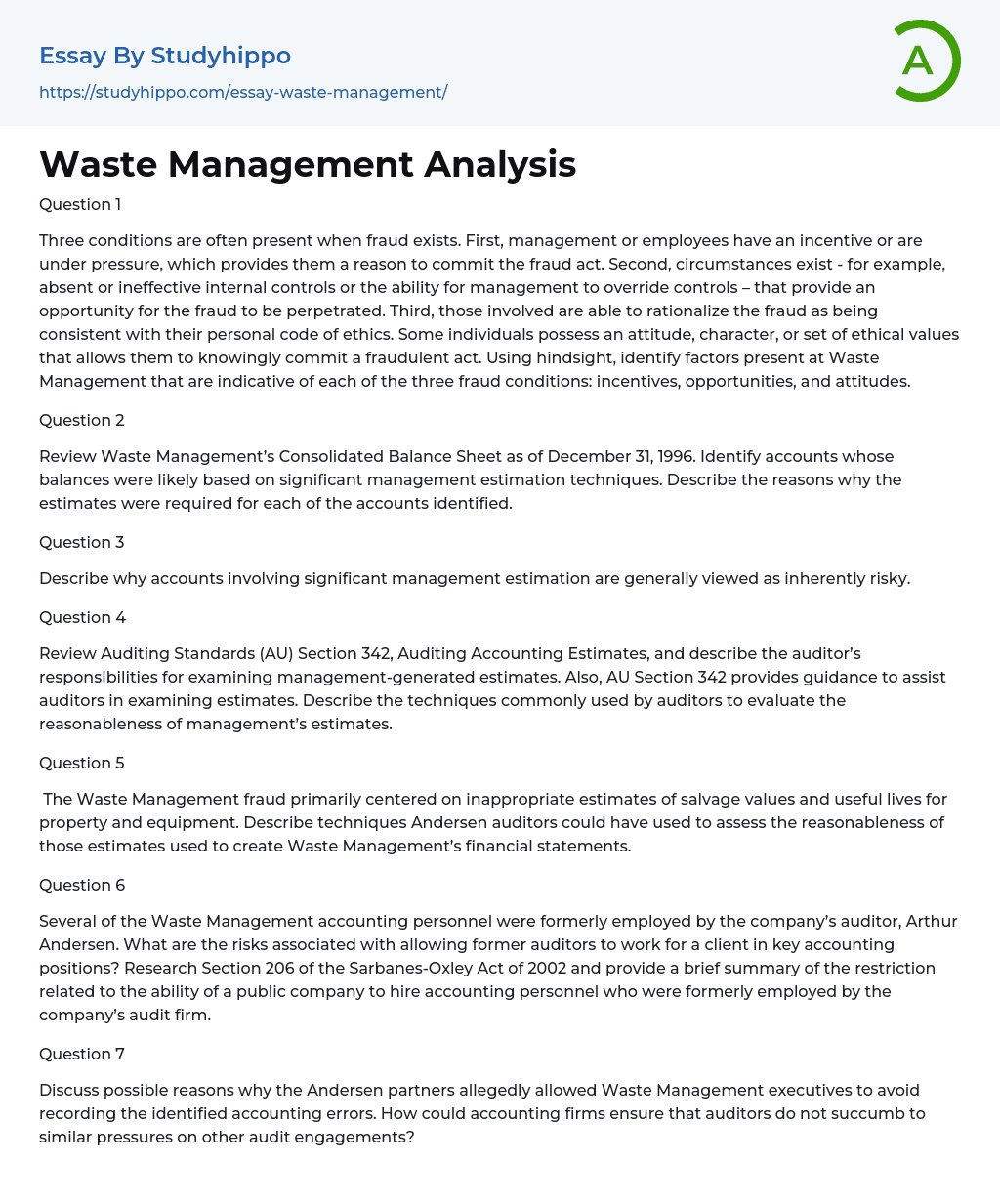Question 1
Three conditions are often present when fraud exists. First, management or employees have an incentive or are under pressure, which provides them a reason to commit the fraud act. Second, circumstances exist - for example, absent or ineffective internal controls or the ability for management to override controls – that provide an opportunity for the fraud to be perpetrated. Third, those involved are able to rationalize the fraud as being consistent with their personal code of ethics. Some individuals possess an attitude, character, or set of ethical values that allows them to knowingly commit a fraudulent act. Using hindsight, identify factors present at Waste Management that are indicative of each of the three fraud conditions: incentives, opportunities, and attitudes.
Question 2
Review Waste Management’s Consolidated Balance Sheet as of December 31, 1996. Identify accounts whose balances were likely based on significant management estimation techniques. Describe
...the reasons why the estimates were required for each of the accounts identified.
Question 3
Describe why accounts involving significant management estimation are generally viewed as inherently risky.
Question 4
Review Auditing Standards (AU) Section 342, Auditing Accounting Estimates, and describe the auditor’s responsibilities for examining management-generated estimates. Also, AU Section 342 provides guidance to assist auditors in examining estimates. Describe the techniques commonly used by auditors to evaluate the reasonableness of management’s estimates.
Question 5
The Waste Management fraud primarily centered on inappropriate estimates of salvage values and useful lives for property and equipment. Describe techniques Andersen auditors could have used to assess the reasonableness of those estimates used to create Waste Management’s financial statements.
View entire sample
Join StudyHippo to see entire essay
justify;">Question 6
Several of the Waste Management accounting personnel were formerly employed by the company’s auditor, Arthur Andersen. What are the risks associated with allowing former auditors to work for a client in key accounting positions? Research Section 206 of the Sarbanes-Oxley Act of 2002 and provide a brief summary of the restriction related to the ability of a public company to hire accounting personnel who were formerly employed by the company’s audit firm.
Question 7
Discuss possible reasons why the Andersen partners allegedly allowed Waste Management executives to avoid recording the identified accounting errors. How could accounting firms ensure that auditors do not succumb to similar pressures on other audit engagements?
- Accounts Receivable essays
- Auditor's Report essays
- Balance Sheet essays
- Costs essays
- Financial Audit essays
- International Financial Reporting Standards essays
- Tax essays
- Accountability essays
- Cash essays
- Principal essays
- Management Accounting essays
- Internal Control essays
- Accounting Software essays
- Cash Flow essays
- Leadership and Management essays
- Change Management essays
- Project Management essays
- Knowledge Management essays
- Operations Management essays
- Quality Management essays
- Risk Management essays
- Scientific Management essays
- supply chain management essays
- Performance Management essays
- Time Management essays
- Brand Management essays
- Total Quality Management essays
- Risk essays
- Manager essays
- Leadership essays
- Business Ethics essays
- Board Of Directors essays
- Product Management essays
- Comparative Analysis essays
- Decision Making essays
- Dispute Resolution essays
- Stress Management essays
- Business Management essays
- Brand Equity essays
- Branding essays
- Nike, Inc. essays
- Market share essays
- Razor essays
- Being A Leader essays
- Servant Leadership essays
- Leadership Experience essays
- Leadership Qualities essays
- Incentive essays
- Accounting essays
- Andrew Carnegie essays




